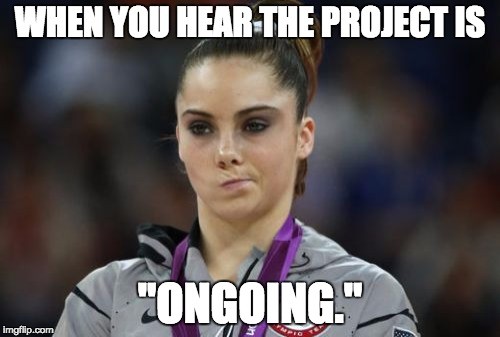Why "Ongoing" is the Worst Word in the History of Project Management
If there’s one word LinkedIn Learning instructor and project manager extraordinaire Chris Croft hates, it’s “ongoing.”
In fact, while filming his Project Management Simplified course, he originally refused to say the word aloud, preferring it was just broadcasted on screen. He eventually caved to the video producer, but his point was made – project managers of all kinds should never, ever use the word ongoing.
Why?
“Because if you say that, what you're really saying is you don't know when it's going to finish,” Croft said in his course. “And, if you think about it, if you're going to plan a project, you have to know when every task starts and finishes.”
The point is if you are asked to give a status update on a project you're managing, and you say it’s ongoing, it’s almost like saying nothing at all. When will the task be done? Is it on-track and under-budget?
Ongoing answers none of those questions, and it's a signal you aren’t managing the project as closely as you should be.
How to avoid using the word “ongoing”
The first step to managing a project is defining the project and what success looks like, Croft said. The second and third steps are about defining each task to get to success, along with the budget and timeline of those tasks.
If you use the word “ongoing” or some variation of it in your status updates, it’s a sign you didn’t do a job on the second and third steps.
Defining each task needed to accomplish success – step two – is critical and can be difficult, particularly if you’ve never managed a project like that before. For example, a longtime general contractor would have an easy time listing out all the steps for building a house, whereas someone who never built a house before would find it incredibly challenging.
How granular should you get for each task? Obviously, you want the tasks to be more specific than “build house”, but “install outlet on the second-floor bathroom above the vanity” is way too specific.
As a general rule of thumb, Croft said a task usually lasts about a week. So, in the example of building a house, digging and pouring a foundation – approximately a weeklong job – is a good example of a singular task.
Of course, there are exceptions. Roofing a house might only take a day or two, but should be singled out as a separate task. Conversely, you could make the argument a singular task could last a month, although Croft warned against having that long of a timeline for one task.
To ensure you've identified all the tasks needed to complete the project, Croft recommends utilizing all three of these methods:
- First, hold a team brainstorm: The first step is to call a meeting with all the members of your team and have them shout out all the tasks that need to get done to complete the project.
- Use a work breakdown structure: Once your team completes its brainstorm, build a work breakdown structure (WBS). For a WBS, build a structured tree diagram of all the tasks you need to do, from onset to the eventual goal. This structured approach quickly reveals if you and your team missed anything.
- Finally, double-check your list with others: Once you’ve completed your list of tasks, compare that list to others, either by doing research or asking other people who ran similar projects. The more input you can get here, particularly from people with experience running similar projects, the better.
Once you have your list of tasks, the third step is to estimate the time and cost of each task. For this, Croft recommends estimating 1-½ deviations from the mean, for both time and cost.
In practical terms, that means halfway between the average and the worst-case scenario. On your commute, for example, if it normally takes you 30 minutes but sometimes it takes you 60 minutes, 1-½ deviations from the mean would be 45 minutes.
“Is it dishonest to add a safety margin?,” Croft said in his course. “I would say, no. The reason I'm adding this contingency isn't really for me, it's for the customer because I want to have a date (and price) that's reliable.”
Think about it this way: if you estimate the average, by definition 50 percent of the time it'll either be more expensive or take longer than predicted. That's unacceptable.
So why those two steps will eliminate the word “ongoing” from your vocabulary.
Okay, back to the original point of this article. If you do both step two and three correctly, you should have each task laid out for the project, along with the cost and expected time of each step.
With that in place, you can track the progress of each task as it goes along. And then, when someone asks you for a status update on the project or any task related to the project, you should never have to use the ambiguous word “ongoing.”
Instead, you can say something much more specific – the task is a day ahead of schedule and 7 percent under budget, for example. Those are the sorts of updates you should be giving, as opposed to saying the project is “ongoing.”
Bottom line, the key to being a good project manager is knowing exactly where your project stands at all times. Saying the word “ongoing” conveys the exact opposite of that.
Looking to become a better project manager? These LinkedIn Learning courses should help:
Topics: Productivity tips
Related articles




